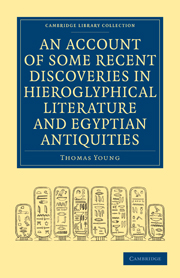 An Account of Some Recent Discoveries in Hieroglyphical Literature and Egyptian Antiquities
An Account of Some Recent Discoveries in Hieroglyphical Literature and Egyptian Antiquities Book contents
- Frontmatter
- Contents
- PREFACE
- WORKS OF THE AUTHOR
- CHAPTER I Introductory Sketch of the Prevalent Opinions respecting Hieroglyphics
- CHAPTER II Investigations founded on the Pillar of Rosetta
- CHAPTER III Additional Inferences, deduced from the Egyptian Manuscripts, and from other Monuments
- CHAPTER IV Collections of the French.—Mr. Drovetti.—Mr. Champollion's Discoveries
- CHAPTER V Illustrations of the Manuscripts brought from Egypt by Mr. Grey
- CHAPTER VI Extracts from Diodorus and Herodotus; relating to Mummies
- CHAPTER VII Extracts from Strabo; Alphabet of Champollion; Hieroglyphical and Enchorial Names
- CHAPTER VIII Chronological History of the Ptolemies, extracted from various Authors
- APPENDIX I Greek text of the Manuscripts and Registries
- APPENDIX II Specimens of Hieroglyphics
CHAPTER II - Investigations founded on the Pillar of Rosetta
Published online by Cambridge University Press: 01 March 2011
- Frontmatter
- Contents
- PREFACE
- WORKS OF THE AUTHOR
- CHAPTER I Introductory Sketch of the Prevalent Opinions respecting Hieroglyphics
- CHAPTER II Investigations founded on the Pillar of Rosetta
- CHAPTER III Additional Inferences, deduced from the Egyptian Manuscripts, and from other Monuments
- CHAPTER IV Collections of the French.—Mr. Drovetti.—Mr. Champollion's Discoveries
- CHAPTER V Illustrations of the Manuscripts brought from Egypt by Mr. Grey
- CHAPTER VI Extracts from Diodorus and Herodotus; relating to Mummies
- CHAPTER VII Extracts from Strabo; Alphabet of Champollion; Hieroglyphical and Enchorial Names
- CHAPTER VIII Chronological History of the Ptolemies, extracted from various Authors
- APPENDIX I Greek text of the Manuscripts and Registries
- APPENDIX II Specimens of Hieroglyphics
Summary
THE pillar of Rosetta was now safely and quietly deposited in the British Museum; the Society of Antiquaries had engraved, and very generally circulated, a correct copy of its three inscriptions; and several of the best scholars of the age, in particular Porson and Heyne, had employed themselves in completing and illustrating the Greek text, which constituted the third part of the inscription: and it so happened that, although no person acquainted with both these critics could hesitate to give the general preference, for acuteness of observation, and felicity of conjecture, and soundness of judgment, to the English professor, yet in this instance the superior industry and vigilance of the German had given him decidedly the advantage, with respect to two or three passages, in which their translations happen to differ.
But Greek was already sufficiently understood, both in London and at Gottingen, to make this part of the investigation comparatively insignificant. Mr. Akerblad, a diplomatic gentleman, then at Paris, but afterwards the Swedish resident at Rome, had begun to decipher the middle division of the inscription; after De Sacy had given up the pursuit as hopeless, notwithstanding that he had made out very satisfactorily the names of Ptolemy and Alexander.
- Type
- Chapter
- Information
- An Account of Some Recent Discoveries in Hieroglyphical Literature and Egyptian AntiquitiesIncluding the Author's Original Alphabet, as Extended by Mr. Champollion, with a Translation of Five Unpublished Greek and Egyptian Manuscripts, pp. 8 - 14Publisher: Cambridge University PressPrint publication year: 2010First published in: 1823


